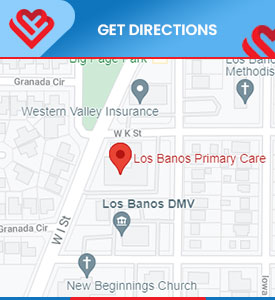Diabetes Management Specialist in Los Banos, CA
It is essential for everyone to control and manage their blood sugar levels to prevent serious health problems such as heart disease, kidney failure, and vision loss. Dr. Raminder Mand, MD, at Los Banos Primary Care can evaluate, treat and manage diabetes. For more information contact us today or book an appointment online. We are conveniently located at 1120 West I St Suite B, Los Banos, CA 93635.


Table of Contents:
What types of diabetes are there?
What are the symptoms of diabetes?
What does a diabetes care specialist do?
How can Los Banos Primary Care help me manage my diabetes?
There are four known types of diabetes mellitus: Type 1, Type 2, gestational, and prediabetes. Type 1 diabetes, also known as insulin-dependent, is believed to be caused by an autoimmune reaction, in which the body’s immune system attacks pancreatic beta cells that produce insulin. When the body consumes certain carbohydrates, it is broken down into sugars, like glucose, to be circulated the body in the bloodstream. As a result, beta cells in the pancreas are stimulated to make the hormone insulin. Insulin is essential as it allows glucose to enter the body’s cells and be used as energy to drive various physiological functions needed for everyday living.
The symptoms of Type 1 diabetes typically develop fast and are usually diagnosed sometime between childhood and early adulthood. Patients with Type 1 diabetes need insulin administered and are more likely to experience diabetic ketoacidosis (DKA).
In Type 2 diabetes, known as insulin resistance, the body produces insulin, but it is ineffective and does not allow for the use of sugar as it should. This type of diabetes develops over years and is often associated with risk factors such as an unhealthy diet, a sedentary lifestyle, and being overweight. Usually, Type 2 diabetes is diagnosed in adulthood, though it has become more prevalent in younger ages.
Of the diabetic population, approximately 10% is attributed to Type 1 diabetes, while the other 90% to Type 2 diabetes. Gestational diabetes occurs in pregnancy due to increased demand for insulin and the inability to produce the necessary amount. Gestational diabetes usually goes away after your baby is born, though it puts you at a higher risk for Type 2 diabetes later. This type of diabetes also puts your child at a higher risk for developing type 2 diabetes and other health problems, and they are more likely to become overweight during childhood. Up to 20% of pregnant women will be diagnosed with gestational diabetes, though it is often asymptomatic.
The fourth and final type of diabetes is prediabetes. In this case, you may experience mild symptoms of diabetes and have higher blood glucose levels. However, prediabetic patients’ blood glucose level (BGL) will be too low to diagnose diabetes mellitus.
Symptoms of diabetes mellitus are not dependent on the type and are relatively similar in all patients, with varying severity, of course. The first and most common symptoms you may notice are metabolically driven, as is the disease. This includes increased thirst and hunger, with more frequent urination, especially at night. Weight may fluctuate unintentionally, and nausea, vomiting, and stomach pains can occur. You might also feel weak or excessively fatigued.
Skin condition is heavily influenced by nutritional status, and it is typical to see drier skin, more bruising, slower healing wounds, and worsening sores. People with diabetes are also more prone to infections; tingling and loss of sensation in the distal extremities, such as the feet, can reduce awareness of sores which may ultimately be left untreated. Many patients also report blurry vision and mood changes. Some men may experience difficulty developing or maintaining an erection.
Finally, DKA, or diabetic ketoacidosis, is a severe complication of diabetes (more frequently with Type 1) in which the liver breaks down fat as a secondary fuel source when glucose isn’t available. This process results in ketone acids which can be life-threatening at high levels. DKA typically develops slowly and is indicated by the three “polys”: polydysphagia (excessive eating), polyuria (excessive urination), and polydipsia (excessive thirst). If left untreated, it can result in tachypnea (abnormally fast breathing) or dyspnea (shortness of breath), muscle stiffness, aches, extreme fatigue, nausea, vomiting, stomach pains, and, uniquely, fruity-scented breath. The skin will look red and feel warm and dry as the body dehydrates. In cases of a diabetic emergency, patients have been mistaken as being intoxicated, as signs and symptoms may look similar to being drunk.
With hypoglycemia, where blood sugar is too low, a patient may be dizzy, have blurry vision, confusion or delirium, weakness, and lack of coordination. In addition, a hypoglycemic patient may have slurred speech, be combative, or fall unconscious. It is essential to distinguish between the two situations to provide appropriate emergency medical help.
Doctors who specialize in diabetes diagnosis and treatment are endocrinologists. Endocrinologists focus on the body’s endocrine system, a network of glands that produce hormones, like insulin, to control physiological processes biochemically. You may be referred to an endocrinologist if your primary care physician isn’t too familiar with diabetes, you have severe symptoms, or traditional treatments have not worked.
With a new diagnosis, an endocrinologist can educate you on managing your condition and provide extra learning material should you need it. Here, you may learn how to administer your insulin injections, insulin pump, or routine glucometer readings. In addition, an endocrinologist may journal BGL readings with you and help determine patterns of symptoms. This specialized doctor can utilize evidence-based practice with their extensive experience in the field and can offer alternative treatments that traditional ones aren’t effective.
Endocrinologists will also keep up with your diet and exercise, guiding you through lifestyle changes that can help alleviate your symptoms. Any complications that may arise, or need for laboratory testing, can be covered by an endocrinologist.
At Los Banos, our primary care physician, Dr. Mand, is fully dedicated to providing quality care, regardless of your concerns. She strives to do so by collaborating with you and any specialists that can aid in your care, such as endocrinologists. You may book an appointment to see Dr. Mand by phone or online. We guarantee your concerns will be heard and properly addressed; you are safe in our hands. Call us today or book an appointment, or visit our clinic conveniently located at 1120 West I St Suite B, Los Banos, CA 93635. We look forward to serving you! We serve patients from Los Banos CA, Volta CA, Santa Nella CA, Trent CA, and surrounding areas.
Check Out Our 5 Star Reviews








